Marines: Almost five years ago, our baby website decided to expand from its usual fare (the terrible books we read as children) to cover a TV show. At the insistence of my friends, I’d watched the pilot episode of Buffy the Vampire Slayer even before the founding of the blog. In fact, “Childhood Trauma” was the first name of this blog, thanks to the classic line in the pilot. When it came time to pick a show to cover here, it seemed natural to start with Buffy.
In a lot of ways, Buffy allowed us to find our style and our audience. Even watching it years after it originally aired, it became an important experience of my 20’s. It remains one of the shows I can talk about with episode titles and one that I reference often and compare to lots of other media.
20 years after the pilot aired, Buffy still matters. It matters to pop-culture, it matters to this website and it matters to me. What is it about this 20-year-old show about a young girl who kills vampires that endures?
Well, we’ve decided to take a crack at the reasons why we think Buffy sticks, perhaps especially with us.
In no particular order:
1. The dialogue.
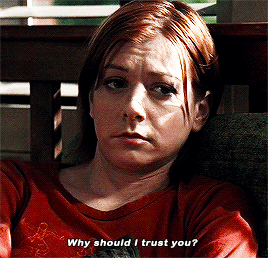

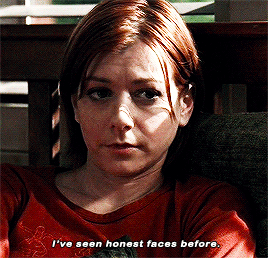

Kirsti: Not only that, but terminology that Whedon came up with in the show has influenced countless other shows. Hell, I’m pretty sure one of the characters in Riverdale (#aroacejugheadorbust) mentioned a Hellmouth in last week’s episode.
Sweeney: It is fitting that a show so layered with cultural references has become such an important cultural milestone in its own right.
The dialogue on this show made these characters feel like friends, and so this show endures like any true friendship.
2. The sass.
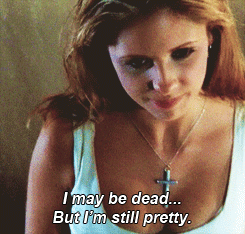
Mari: There was something about the sass and swagger of Buffy that made her supremely easy to root for. Things sometimes got dark on this show, but it was balanced well by the incredible amounts of sass wielded by our heroine. There wasn’t ever really a time when she wasn’t punning and running.
Kirsti: “If I were at full Slayer power, I’d be punning right about now” is a standout for me. Self-sass while also sassing the villain.
Sweeney: “I may be dead but I’m still pretty,” is a forever favorite, not because it’s one of Buffy’s best, but because it sells so much of who this character is.
I still want to grow up to pun and run just like Buffy.
3. The friendships.
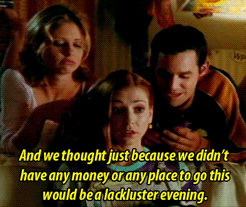
Mari: Yeah, I chose a gif from “Reptile Boy.” Of all the friendship moments I could’ve picked, I think it’s telling that this is one that stands out in my memory so clearly (along with the tackle hug). Perhaps it’s because over the years, supernatural activity really tested the limits of this friendship and so the more “normal” moments standout to me. In the same scene from above, Buffy makes a comment about how nice it is to hang out with friends and not have to fight bad guys. Her longing for some semblance of normality, for dates and college and friends, follows her story for a while and it makes me happy that she found that in Xander, Willow and the rest of the Scoobies.
All of that to say that the depiction of friendship is fundamental to this story and its success. As much as this is Buffy’s story, the side characters all manage to take center stage at one point or another, to the point that I’d venture to say that Buffy suffers Harry Potter syndrome. I just made that up, but it means that if you ask fans of this show who their favorite character is, most times Buffy is overlooked for other members of the Scooby gang. They work together well because they work as individual characters. And just like the sass, it is the core of friendship that really helps balance the show’s darker moments.
4. The good.

Mari: Across our time watching Buffy, we did a lot of ranking. Ranking by season, ranking the seasons, and of course talking about the very best episodes. When Buffy was good, it was amazing. I stand by “The Body” as one of the best episodes of TV, ever. I think about the muted soundtrack, about the sentiments conveyed concerning grief, and I still feel the same rush of feelings I felt the first time. It was both emotional and brilliantly executed. Plus, it was a development in the story I didn’t expect at all as a first time watcher.
“Hush” and “Once More With Feeling” both play with sound and music in ways that are incredibly memorable. Once More wasn’t only a musical episode, but it was smart in the way it progressed the story arc. It wasn’t just a “something different” episode. It mattered.
Think of episodes like “Restless” and “Normal Again” and “Storyteller” and how absolutely brilliant they were in their break from typical TV. Season openers like “Bargaining” Parts 1 and 2 and season finales like “The Gift” and the already mentioned “Prophecy Girl” and honestly, I could go on for a while. The point is that Buffy endures because it’s quality storytelling. While the look and costumes and effects may date badly, quality storytelling doesn’t. (And anyway, all of it helps the show stick. Keep reading.)
5. The bad.
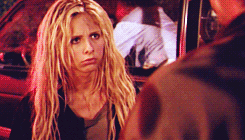
Why include this on a list of why Buffy endures? Maybe because the image of Buffy with her crimpy hair as a cave woman is burned onto my retinas. You can’t forget storylines about space roaches and robot mom dates and sorority snakes, for better or for worse.
Kirsti: Personally, I will never be over “Living Conditions“, in which Buffy collects her roommate’s toenails to prove she’s a demon… That, and the penis monster in “Doublemeat Palace.” *shudder*
6. The ugly.
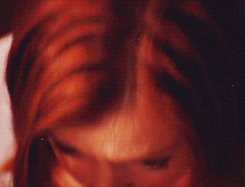
Mari: 20 years later, start a conversation with anyone who watched Buffy about Spike or Buffy’s depression in season 5 or “Seeing Red” and get. ready. There were some really tough, ugly moments during the course of the series and I mean that for both in- and out-of-story reasons. Buffy went through a lot, but so do the viewers. Like the previous entry, while that doesn’t seem like a ringing endorsement of the series, I think it adds to this conversation of why Buffy sticks. I’ll always be ready to talk about the nuances of the story and specifically about why I think it got some of its messaging about Buffy’s sexuality and her attempted rape completely wrong.
Sweeney: There’s also something of the personal here, for us. Blogging this show was a PROJECT in a way I don’t think we’ve encountered since (K: AGREED). It was that way because this show endures and people come to it filled with feelings.
And so it meant that our life experience of the show became good, bad, and ugly too. (But mostly very, very good.)
7. The cry-worthy.
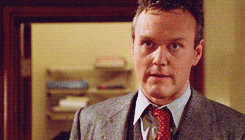
Mari: Around the Buffy recaps, we came up with two terms to describe our varying emotional investments: Team Feels and Team Heartless Cow. Sweeney and I were typically #teamfeels and Kirsti was solidly #teamheartlesscow (K: Still am), but there were moments during the series where we were all completely lost to the heartbreak and emotions. Why does Buffy endure? Because it plays to such common, human emotions nestled in the middle of a story about more fantastical fears and dangers. The Big Bads are important, but I think the most memorable and enduring moments are watching Buffy face things like her parent’s divorce, her first love, her breakups, Giles letting her down, her mother’s death, her depression– it made all made me cry. It all cemented this story as one that feels evergreen, because feelings are forever.
Kirsti: I also love that the cry-worthy moments aren’t all related to Buffy. We get Willow’s break up with Oz, Willow debating her sexuality, Willow losing Tara, Willow’s guilt over Warren. We get Anya not knowing how to react to Joyce’s death. We get Dawn realising that she’s not a Slayer. We get Xander losing an eye. Every single character has SOME moment over the course of the seven seasons that breaks your heart.
Sweeney: Buffy’s speech in “The Gift” is a thing I have actually thought of in personal dark times and seeing gifsets of it on Tumblr makes me emotional. Also that episode has those unique moments for everybody, which is great. I just really love “The Gift,” you guys.
8. The ridiculous.
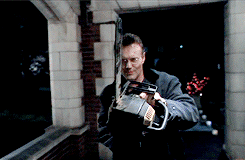
Sweeney: But also… there are other moments where the show made choices that I will never understand. This show’s high highs made its lows all the more pronounced, because we knew it could be better than that. And what’s fun about this show is that it’s moments of absurdity also span the range of quality outcomes.
“Fear Itself” is absurd but also fantastic. Meanwhile, I am still wishing I could erase the memories of “Where the Wild Things Are.” For all of its turns, the show knew how to keep shit interesting. And really, how can one forget the time Buffy and her worst boyfriend entered some weird poltergeist raising sex trance?
(Serious question: how can one forget?)
Kirsti: Brain bleach is the only way I know how, but we used all of that during season 4 of Angel. So…
Anyway, back to the point. “Halloween” is another one that, for me, feels totally ridiculous and yet is somehow completely endearing. In contrast, “Doublemeat Palace” and “The Puppet Show” and “Buffy vs Dracula” are ridiculous in a memorable but not-so-great way.
Mari: I think the fact that this item contains good and bad is the reason it deserves to be its own entry on the list. Often times, some of my favorite things on this show were also just plain ridiculous in ways that make it worth experiencing because where else will you see this shit? My examples include my favorite villain (The Mayor) turning into a giant snake monster for reasons that are still beyond me, Willow’s doppleganger and honestly I can’t be the only one who thought “Doublemeat Palace” wasn’t THAT bad…
9. The groundbreaking.
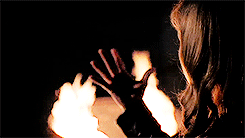
Sweeney: I watched this show for the first time years after it aired, but even still, it was clear how much the TV landscape I knew owed to this show.
Whedon’s flare for bending conventions and playing with the format is key to Buffy’s legacy. Even now, 20 years later, things like the silence of “Hush” are unique and clever, but as Mari noted earlier, they’re unique and clever with a purpose.
The show took a lot of risks and sometimes we felt like it was taking those risks for risk’s sake, but more often than not it was about advancing the story and these characters in exciting ways.
Kirsti: It’s interesting how quickly it’s become de rigeur for a show to do a musical episode (Grey’s Anatomy comes to mind for all the wrong reasons…). At least in the case of Buffy, the songs actually fitted with the plot of the show – both for that episode and for the season as a whole. So while it may be a little bit passe now for a show to do a musical episode, Whedon genuinely did something new and different and groundbreaking with “Once More With Feeling.”
10. The costumes.
Sweeney: Buffy’s high school wardrobe was everything I, an 8-10 year old child, also aspired to wear at that time. Make of that what you will.
Importantly, this show also endures because Willow’s fashion choices have given this blog a very important award, so, there’s also that.
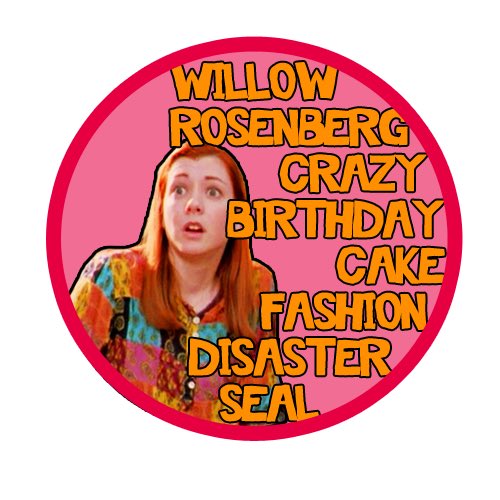
Kirsti: Oh Willow. I honestly can’t decide if my favourite is the fuzzy smily face jumper from “Doppelgangland” or whatever the hell this is:

Mari: Willow was probably the greatest offender, but everyone participated. Everyone. Like, I can vividly imagine the outfits of the pilot, from Xanders jellyfish printed shirt (?) to the high-watered bell bottoms Buffy wears to The Bronze. When Angel first appears, he’s wearing crushed velvet. That’s not even saying anything about Cordelia.
However, I think there were moments that the costumes also felt kind of iconic. The example I first thought of was (hold your shock) “Prophecy Girl.” Was there ever anything more Buffy than Buffy in a pretty white virginal prom dress and leather jacket?
11. The D grade special effects.
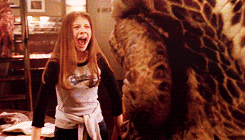
Sweeney: Angel’s face going all wiggly in that episode with Ethan is still lolforever, but also kudos and high fives to this show for trying to do things it clearly had no budget for.
If nothing else, it makes for one hell of a drinking game.
Kirsti: I have an unnatural soft spot for the terrible special effects in Buffy, whether it’s the season 1 “Okay, now shake your head back and forth, then we’ll cut and have you shake your head back and forth in your vampire make up and cut the two together!” or any of the numerous giant snakes over the seasons. It’s not quite the same soft spot I have for the BBC props department using kitchen utensils as alien devices. But it’s close.
12. The concept.
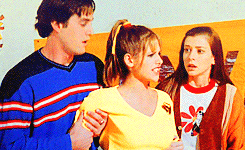
Sweeney: Of all the show’s metaphors, the high school on a Hellmouth might be the one that I loved most. It took this silly, supernatural show and made it feel real. You felt unseen in high school? Cool, well someone actually becomes invisible because Hellmouth.
Being a teenager is complicated and intense in all these ways that can be hard to articulate and somehow amplifying with sci if weirdness was the perfect solution. It makes vampires and demons somehow #relateable
Mari: I think the college as hell thing was even onto something (Kirsti mentioned the roommate from actual hell) but season’s 4 larger problems are another topic. Point is that using a supernatural stand-in for basic problems was great. Additionally, the entire idea of this teenage girl being a bad-ass hero while trying to navigate “normal” life is one that still makes me excited to watch. Which I suppose brings us to:
13. The Girl Power.
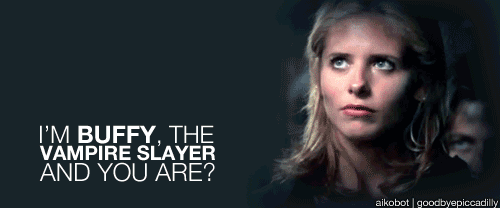
Sweeney: Right away, Buffy is a super powered badass who also wants to wear makeup and go to the mall and she gets to be all of those things at once and, by extension, all of those things get to be feminine at once.
But Buffy also had some wonderful female foils over the years. We got to see female characters kick ass and fuck up in all kinds of ways with Willow and Faith and Anya and the bizarre Big Bad that was Glory.
The show sucked at a lot of other representation, but it was a multifaceted girl power party.
Mari: I love that in addition to being feminine and a badass, Buffy also got to be vulnerable. Too many times, strong translates to being emotionally closed off, especially for female characters. Not our girl, who from the beginning is super honest about her reluctance to sacrifice her life for her calling. I think showing such multi-faceted girls is why this show excels at (most of) what it taught us about girl power.
14. The big speeches.
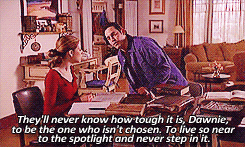
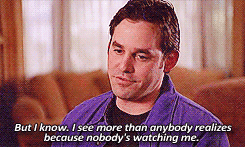
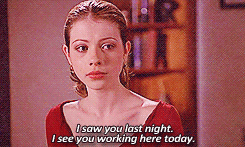


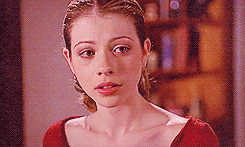
There is a Buffy motivational speech for every occasion, so how could this show not endure?
Mari: I think one of the most memorable for me comes from Xander in season 7, when he and Dawn bond about being everymen. Look, guys, we have a whole blog tad dedicated to big speeches on TV. It’s a thing.
15. The Big Bads.
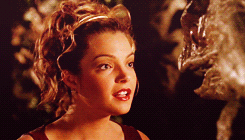
Kirsti: What changed most over Buffy’s seven years was the villains. Buffy was always the hero and the Scoobies were always there for her (shhh, let’s just forget those few episodes at the end of season 7). The variety came in the Villain of the Week and the Big Bad. Some of them were completely terrible (*cough* Doublemeat Palace*), but some of them were absolutely amazing. If you asked me to rank my top TV villains, The Mayor would be right up there. The Master probably wouldn’t make the list because he’s ridickity, but is he an iconic and memorable symbol of the show? HELL YES.
Mari: I loved them as season arcs, which usually worked to infuse a bit more tension and gravity into the story. The Villain of the Week might be defeated by the end of the episode, but we had to keep watching to figure out how Buffy beats The Master or her boyfriend turned evil or The Mayor etc. It also helps pinpoint moments in the show and in Buffy’s character arc. Anything that makes this more memorable or easier to reference helps its sticking power.
16. The morally grey.
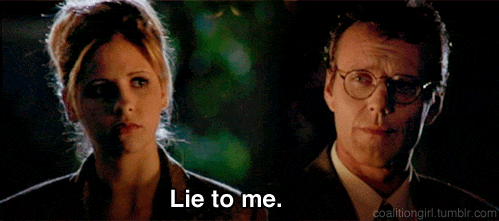
Kirsti: In season 2’s “Lie to Me“, Buffy asks Giles if life ever gets easy and asks him to lie to her (earning her a gold star, but that’s not the point right now). His response is “Yes. It’s terribly simple. The good guys are always stalwart and true. The bad guys are easily distinguished by their pointy horns or black hats, and, uh, we always defeat them and save the day. No one ever dies and… everybody lives happily ever after.”
But Buffy excelled at characters who occupied the moral grey zone. Characters who don’t do the right thing. Characters who are messed up but are still trying. Characters like Clem, who’s trusted to look after Dawn and who Buffy’s always happy to see, but who’s still a demon who plays kitten poker. Characters like Faith, who stakes first and asks questions later. Characters like Spike at the end of season 2: decidedly evil, but still helping to save the world because this is where he keeps all his stuff. Characters like Anya, who’s technically human but doesn’t have the same morals as the rest of the Scoobies, courtesy of a millennium of demoning.
And characters like Giles. We’d like to think that Giles is one of those stalwart and true good guys. But his Ripper-era past indicates otherwise. The way he handles Jenny’s death indicates otherwise. And the way he steps up and kills Ben – with his bare hands – because he knows Buffy won’t be able to most definitely indicates otherwise.
17. The relationships.
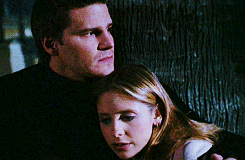
Kirsti: The romantic relationships are certainly iconic and an eternal cause for argument within the fandom. But for me, it’s the OTHER relationships that make the show memorable. Every TV show has its iconic romantic relationships. But not every TV show has the friendships that Buffy has, as we discussed earlier. Not every show has the relationship between Buffy and Giles. Not every show has the sibling feels of Buffy and Dawn. Not every show has the weirdly complex blend of sister/friend/enemy/rival(/possible love interest) that Buffy and Faith had. And those for me stand out far more than the romantic relationships.
Mari: I agree with all of that definitely… though shout-out to the romantic relationships. Willow and Oz and Willow and Tara are equally as important and iconic to me. Xander and Anya are probably one of the more devastating relationships I’ve watched. And Buffy’s boyfriends all have some serious issues, but they provide endless fodder because they are so complicated and because we care so much. And yeah I picked a Bangel gif for this entry. Ha ha ha ha ha #trolling
18. The spin off.
Kirsti: It’s hard to discuss Buffy without also discussing Angel. Was season 4 an abomination that should never be discussed again with the exception of Faith’s redemption arc? Uh, YES. But season 1? Season 1 was INCREDIBLE. It took these two (later three) characters that we knew and loved (or loved to hate) from Buffy and it gave them life. It gave them depth. It gave them character development. And it gave them humour.
Don’t get me wrong, I love the Angel that we see in Buffy. But it’s in his own show that we see his sense of humour and his incredible awkwardness, which made him far more relatable. It’s in Angel that we see Cordy as being useful for more than her car, as more than the bitchy popular girl in the antagonistic relationship with Xander. It’s in Angel that we see Wesley as more than a joke. And for me? It’s impossible to think of Faith’s story without thinking of Angel, because that’s where her redemption arc happened, and I maintain that it’s one of the best redemption arcs in television history.
Sweeney: Having seen Angel and having all of my mixed feelings about it, I also definitely feel that a BtVS-only understanding of Cordelia and Faith is deprived.
And while this is mostly because two shows, two related-but-ultimately-distinct spaces, it’s also an interesting play on perspective. Who you are to one person isn’t who you are to everyone.
Mari: The moments of crossover were also epic enough that a viewing of Buffy without a viewing of Angel means you are missing something.
19. The Wiggins Library


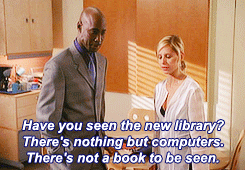
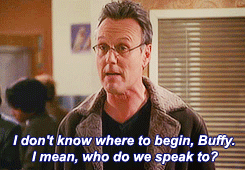
20. The fandom, which is still going strong after 20 years.
Kirsti: I’ve always been on periphery of fandom. As a teenager, I was trash for The X-Files, but mostly showed my status as a fan by buying X-Files t-shirts and posters and novels. I’d seen odd episodes of Buffy during high school and didn’t really get what all the hype was about. And then in late February of 2002, I caught a rerun of “The Gift” which Channel 7 was replaying in preparation for airing season 6 the following week. And I was HOOKED.
When I went to uni the next day, I mentioned to a Buffy-mad friend of mine that I’d finally seen an episode, and she was like “OMG YES LET ME SEND YOU ALL THE THINGS”. Thanks to her, I got through my Honours thesis in 2004 with “Just write 250 words and you can go watch an episode of Buffy” because she owned the entire show on DVD. It’s thanks to her that I found websites full of quotes and images and fan discussions and memorabilia. It’s thanks to her that my “ew, sci-fi is dumb” former self watched Firefly, but that’s besides the point. In short: it’s thanks to her that I found fandom.
The Buffy fandom has had its turf wars, like any fandom. But after 20 years, to have a fandom that is still THIS passionate and THIS dedicated to a show that had a special effects budget of whatever small change they found down the back of the sofa? That we still have a fandom that talks in quotes and episode titles, that we still have a fandom who wants to see the actors at conventions, saying their most iconic lines? That’s pretty damned astonishing.
Sweeney: This fandom is truly remarkable. The way in which we joined it here on the blog affected my life in all sorts of little ways and ultimately that is probably the main reason this show endures, for me, at least.
I am very grateful that our time in Sunnydale let us meet so many thoughtful, funny, lovely people in this corner of the internet.
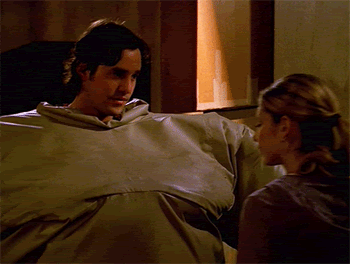
We’d love to hear in the comments what makes Buffy stick with you! Is there anything we missed on our list?